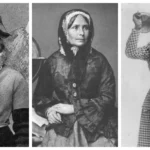Prepare to be captivated by the enigmatic tale of Grace Marks, a woman whose name has haunted Canadian history and legend. Through the pages of “The Enduring Enigma of Grace Marks,” you’ll unravel the chilling mysteries that have swirled around Grace’s life and the infamous murders of 1843. We’ll dive into the historical accounts and explore the psychological depths of Grace’s experiences, peeling back the layers of truth, memory, and the relentless pursuit of justice.
A Twisted Tale of Murder and Intrigue
Grace Marks’s story isn’t your typical history lesson. It’s a twisted tale that blends shocking murders, whispers of hidden motives, and the strict social rules of Victorian Canada. Born in Ireland around 1828, Grace immigrated to Canada in 1840, seeking a better life. However, her journey led her to become a servant in the home of Thomas Kinnear, where tragedy would strike in 1843.
Imagine the quiet town of Richmond Hill rocked by the brutal murders of Kinnear and his housekeeper, Nancy Montgomery. Suspicion quickly fell upon two servants: Grace Marks and James McDermott. The evidence appeared substantial, leading to McDermott’s sentencing to death by hanging. Grace, a teenager at the time, was sentenced to life imprisonment.
The Trial: A Search for Answers or a Rush to Judgment?
The trial, however, ignited fierce debate about Grace’s role in the murders. Was she an active participant, or a vulnerable young woman manipulated by McDermott? Adding to the intrigue, Grace’s mental state became a central issue. Some believed she suffered from mental illness, possibly driven to insanity by her experiences.
For nearly three decades, Grace endured the harsh realities of prison life, including time at the notorious Kingston Penitentiary. Then, after almost 30 years, she received a pardon in 1873. Her release, however, wasn’t a clear-cut declaration of innocence, and the reasons behind it remain shrouded in mystery.
A Life Reclaimed or a Disappearance into the Shadows?
What happened to Grace after her release? She seemingly vanished into thin air, her whereabouts and activities unknown. This lack of information has only fueled speculation, adding to the mystique surrounding her case.
Despite the mysteries surrounding her, Grace’s story has captivated generations. Writers like Susanna Moodie found inspiration in her case, and Margaret Atwood’s novel, “Alias Grace,” brought her story to life for a new audience. The Netflix adaptation of Atwood’s book further propelled Grace’s story into the spotlight.
What Actually Happened to Grace Marks?
After three decades of imprisonment, Grace Marks was granted a pardon in 1873. The reasons behind her release are still debated today. Some believe she was innocent all along, while others speculate that her mental state or even political pressure may have played a role.
Adding to the intrigue, upon her release, Grace seemed to disappear entirely. Her whereabouts and activities after prison remain a mystery, leaving us with more questions than answers. The lack of information has only fueled speculation about her later years.
The fact that we may never know the full truth about Grace Marks is part of what makes her case so captivating. Was she a cold-blooded killer or a victim of circumstance? Did she find peace and anonymity after her release, or did the shadows of her past follow her? These are questions that continue to fascinate historians, true crime enthusiasts, and anyone who hears her story. The case of Grace Marks serves as a stark reminder that some mysteries may never be fully solved.
## Unveiling the Asylum: Grace Marks and the Provincial Lunatic Asylum
A Controversial Chapter
In 1852, after nine years at Kingston Penitentiary, Grace Marks was transferred to the Provincial Lunatic Asylum in Toronto. This transfer, likely prompted by claims of insanity, raises questions about the subjective nature of psychiatric diagnoses during that era.
The Superintendent’s Verdict: Sane or Insane?
The asylum’s superintendent played a pivotal role in Grace’s story. After observing her, he concluded that she was not insane and recommended her return to prison. This decision highlights the immense power held by medical authorities at the time and the limited agency afforded to women like Grace.
The Asylum’s Impact: A Deeper Look
Grace’s time in the asylum remains shrouded in mystery, with limited records offering a fragmented glimpse into her experience. However, her case provides a valuable opportunity to examine the treatment of women within the 19th-century asylum system and the often-biased nature of “insanity” diagnoses.
Was Grace Marks Innocent?
The trial of Grace Marks captivated the public in 1843. Accused of participating in the brutal murders of her employer, Thomas Kinnear, and his housekeeper, Nancy Montgomery, Grace’s case continues to spark debate about her guilt or innocence.
The evidence against Grace was far from clear-cut. While she worked in the house and gave conflicting statements to authorities, there was no physical evidence directly linking her to the murders. Some witness accounts suggested she had argued with the victims, but these accounts were often unreliable and colored by the sensational nature of the case.
Several factors raise doubts about Grace’s guilt. At 16, she was a young, working-class woman, vulnerable to manipulation by both McDermott and authorities. There were also allegations that her confession was coerced, as she had no legal representation during questioning.
The inconsistencies in Grace’s accounts, rather than confirming her guilt, might suggest trauma, mental health issues, or attempts to protect herself. The lack of physical evidence further complicates the narrative, leaving room for reasonable doubt.
While some believe Grace was a cunning manipulator, others see her as a traumatized young woman ensnared in a web of deceit. Her story serves as a cautionary tale, highlighting the potential for miscarriages of justice, especially against women from marginalized backgrounds.
These 3 women’s stories were covered in our previous article; you can read the full story of why they are being called by clicking on giulia tofana, grand duchess tatiana nikolaevna of russia, and grete winton.
Key Points:
- Grace Marks, born in Ireland in 1828, was accused of participating in the murders of Thomas Kinnear and Nancy Montgomery in 1843.
- The trial resulted in death for James McDermott and life imprisonment for Grace due to conflicting evidence and uncertainty about her mental state.
- Grace’s prison sentence lasted nearly 30 years, after which she was pardoned and her whereabouts remain unknown.
- The case sparked debates about Grace’s culpability and the influence of mental illness on her actions.
- Grace’s story has inspired writers like Susanna Moodie and Margaret Atwood, whose novel “Alias Grace” brought it to a wider audience.
- Modern researchers continue to investigate the case, examining social dynamics and potential forensic clues to shed light on the unsolved aspects of the murders.
- Grace Marks’s story highlights the enduring mystery of history, leaving unanswered questions and complex characters whose motives remain elusive.
- Discover the Borough of Frenchtown, NJ: A Delaware River Town Blending History, Art & Nature - November 22, 2024
- Discover Clarks Grove, MN: A Small Town with a Big Heart - November 22, 2024
- Califon Borough, NJ: A Small Town with a Big Heart (and Rich History) - November 22, 2024














2 thoughts on “Here is a title relating to the provided context, incorporating the keyword Grace Marks and aligning with the competitor-provided theme:The Enduring Enigma of Grace Marks: Murder, Mystery, and History Unveiled”
Comments are closed.